During World War I the British had used the formidable .455 Webley Mk. VI but they found that it took too long to train soldiers to use the heavy pistol with any accuracy. After several years of searching it was determined that a smaller .38 caliber pistol would be as effective and could be put in action with less training.
Between the wars most armies were adopting self-loading pistols, the British Military continued to hold on to the conservative notion that revolvers were more sturdy and more accurate than "Automatics". With this mind set, the Enfield No. 2 Mk. 1 and later the No. 2 Mk. 1* was adopted for military service.
The Browning 9mm HP35 would not come into service in large numbers until after the end of the desert campaign. At that time, almost all special forces units, such as Airborne troops and the SAS operating in NW Europe would trade in their revolvers for the reliable Browning Pistol.
Enfield Revolver No. 2 Mk. 1
The Enfield Service Revolver was patterned after the Webley Mk IV revolver which it closely resembles. In fact it is believed the Army constructed the Enfield revolver by taking the Webley Mk IV apart and rebuilding with just enough differences to make it entirely impossible to have the part interchangeable! Both revolvers were a six shot single/double action revolver firing a caliber .380 SAA round. At one pound eleven ounces it was relatively light. The bullet was underpowered compared to most service pistols of the time.
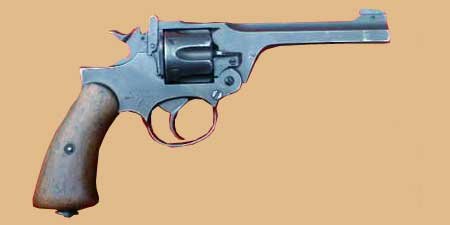
- Overall Length: 10.25 inches
- Caliber: .380 SAA
- Barrel: 5 inches
- Muzzle Velocity: 650 FPS
- Magazine : 6 shot cylinder (break open)
- Action: Single or Double
Note: The No.2 Mk. 1* was a double action only version with the trigger spur missing and the sear changed. It was claimed the change was done because tankers had complained about the trigger catching on items inside the tank but it is believed it was actually just a cost saving feature and the complaints were just an excuse. The Mk1* was less effective due to the excessive trigger pull.
Webley Mk IV
Due to shortage of revolvers at the outbreak of the war, The Webley Mark IV. The Webley was slightly better made and unlike the Enfield was never modified into a hammerless double action revolver.

- Overall Length: 10.25 inches
- Caliber: .380 SAA
- Barrel: 5 inches
- Muzzle Velocity: 650 FPS
- Magazine : 6 shot cylinder (break open)
- Action: Single or Double
Smith & Wesson 38 Military.
S&W revolvers were first used by the British Army in World War I and they continued to be used throughout World War II.
Photographic evidence suggest the S&W was popular with the LRDG. It was slightly more powerful due to a longer barrel and had less trigger pull making it easier to fire and more accurate. The revolver was chambered to accept the same .380 SAA 200 grain cartridge used in the other service revolvers. The round is also called the .380 Webley.
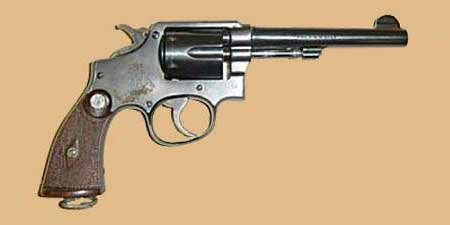
- Overall Length: 10.2 inches
- Caliber: .380 SAA
- Barrel: 5.5 inches
- Muzzle Velocity: 770-860 FPS
- Magazine : 6 shot cylinder (swing-out)
- Action: Single or Double
Non- Standard Sidearms
Three pistols fall into the non standard category. The first, the Colt .45 automatic was issued to troops but is considered non standard because of the ammunition used in the pistol. The second is the Webley M1906 which was widely used by the British and the Commonwealth but never officially adopted for military use by the British Army. The final is the M1917 revolver which was chambered to fire the .45 ACP cartridge and available via Lend Lease and also from existing stocks in the Great Britain.
M1911A1 Colt 45 Automatic
Another favored weapon was the Colt 45, Automatic pistol (M1911A1). The pistol fired the same .45 ACP ammunition as the Thompson submachine gun. It was battle tested and not too difficult to come by. Indeed it was issued to Commandos as a sidearm and continued service in the British Army in the Mediterranean theater through out the war.
While the pistol was issued it is considered non-standard because the 45 ACP round was not a standard round in British inventory.
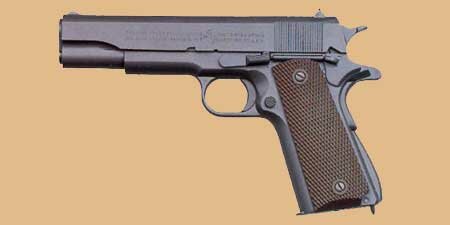
- Length: 8.625 inches
- Length of barrel: 5.03 inches
- Weight: 2.5 pounds unloaded
- Muzzle velocity: 830 FPS
- Magazine capacity: 7 rounds
- Action: Self loading, single action
Webley & Scott .32ACP Self Loading Pistol
The M1906 Webley & Scott was adopted by the London Metropolitan Police in 1911. It is sometimes referred to as the Webley MP for this reason.
Production of the highly popular pistol lasted until 1940 The first examples of this weapon had the safety on left side of the hammer, but later models moved the safety to the left side of the frame, where it could also lock the slide.
While never officially adopted by the British Army it was widely used unofficially by British and Commonwealth forces in both World Wars, with many British officers and NCO's carrying it as a back up. It was also widely adopted by many colonial forces, including those in Palestine. The pistol was small, sturdy and reliable. It was extremely accurate at short range, making it a terrific concealed weapon.
(Because it was so widely used by British officers and NCO's I have included here instead of on the page of unlikely weapons)
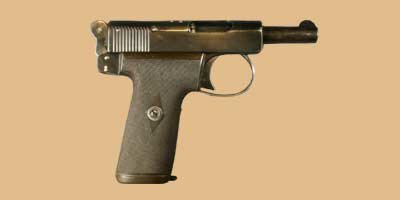
- Weight: 0.57 kg (1.3 lbs)
- Barrel length 8.9cm (3.5 inches)
- Ammunition: .32 ACP (7.65mm)
- Operation: Blowback
- Action: Single action, semi-automatic
- Magazine: 8
M1917 Revolver (Colt / Smith & Wesson)
During World War I, the U.S. Army found itself short on M1911 Colt 45 automatics and issued contracts to both Colt and Smith &Wesson to produce double action revolvers that would accept the .45 ACP cartridge. Colt modified its model 1909 revolver to accept the round. S&W adapted its Second Model .44 hand ejector to accept the .45 ACP.
The revolvers were made available to the British in the early stages of World War II through the Lend Lease program and proved popular within the British Army which continued to embrace the simplicity of revolvers long after other armies had adopted automatics. A principal advantage of the M1917 over other revolvers is that its ammunition was interchangeable with the Thompson submachine gun. Paddy Mayne of the SAS carried a Colt M1917 throughout the War.
The popular revolver also shows up in photographs of LRDG members especially the S&W model..
A draw back of the M1917 revolver is the muzzle velocity was less than that of the M1911a1 Automatic pistol. This is due to the gap between the revolver's cylinder and the barrel which allows some of the propellant gasses to escape.
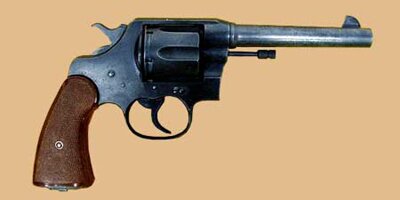
Colt Model 1917 Revolver
- Weight : 2.5 lb (1.1 kg) (Colt)
- Weight: 2.25 lb (1 kg) (S&W)
- Length: 10.8 in (274 mm)
- Barrel length: 5.5 in (140 mm)
- Ammunition: .45 ACP,
- Action: single or double action
- Muzzle velocity: 760 ft/s ( 231.7 m/s)
Read more:
